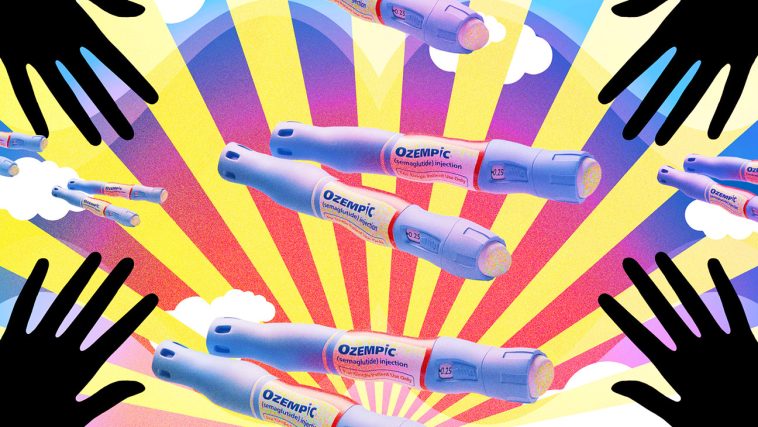On a chilly January evening, Samira Shamoon, a 44-year-old health and beauty publicist, walked into an Italian restaurant to meet friends. They were stunned by the incandescence of her skin. Her cheekbones appeared more defined. After a flurry of questions about which dermatologist or plastic surgeon she had visited, she said, beaming, “I’m microdosing!”
Shamoon has joined the wave of people who are taking limited amounts not of psychedelics — to which the microdosing trend usually applies — but of the diabetes drug Ozempic (semaglutide), and other GLP-1 receptor agonists like Mounjaro. They are doing it not primarily for weight loss — the effect that has made Ozempic a Hollywood staple and a reliable awards-show punchline — but for the surprising and widely touted side benefits, particularly its anti-inflammatory properties. Rather than injecting the regular introductory weekly dose, people are only taking half that amount or less. As a runner, Shamoon was always fairly svelte, and though she didn’t mind the side effect of dropping 4 pounds, it was losing the puffiness in her face that drew her to the prescription drug. She also found intriguing the promise of increased mental clarity and a decreased risk of heart disease, Alzheimer’s, multiple sclerosis and Parkinson’s.
“I no longer wake up feeling like a puffer fish,” she says. And, she believes, the drug is increasing her mental clarity: “I just feel sharper.”
Dr. Caroline Messer, a top Manhattan endocrinologist, reported that many of the people asking her about microdosing have come in because they are genetically predisposed to Alzheimer’s. “The key is not decreased blood sugar,” she says, “but decreased inflammation. In patients without diabetes, it doesn’t lower blood sugar but still has an anti-inflammatory effect.” And, it makes sense, she notes, because “Alzheimer’s is sometimes referred to as Type 3 diabetes. The brain in someone with Alzheimer’s exhibits insulin resistance, similar to what is seen in Type 2 diabetes.”
Microdosing can have a lasting effect in achieving a mental edge, says Dr. Anetta Reszko, a Park Avenue dermatologist. “Unlike traditional dosing, which primarily targets appetite suppression and glucose regulation, microdosing semaglutide may provide a more gradual, sustained effect on the brain, immune system and overall cellular health,” she notes. “By modulating these pathways, it may help reduce neuroinflammation, a key factor in cognitive decline and neurodegenerative diseases.”
Dr. Amanda Kahn, an internist and longevity specialist, says her patients who are microdosing are reporting “more clarity and energy” as well as fewer aches and pains. “I have patients with rheumatoid arthritis that were never pain-free until trying this,” the doctor notes.
Dr. Babak Azizzadeh, a top Beverly Hills facial plastic surgeon and co-founder of a medtech aesthetic concierge service, Persana, says L.A. in particular is seeing a surge in the trend. “Microdosing of GLP-1 receptor agonists is a huge thing in the SoCal community,” he notes. “It reminds me of Botox, which expanded from medical to cosmetic use, then began being used for headaches and depression. Initially people were using this for diabetes, then weight loss, and now are seeing other health benefits.”
The patients of Los Angeles internist and obesity specialist Pooja Gidwani are microdosing GLP-1s as part of a longevity approach. “It’s becoming more and more mainstream in the Hollywood community, and many want to do this in combination with peptides,” says Gidwani, who offers GLP-1s along with IVs of the co-enzyme NAD.
Addiction and obsessive behavior are other targets of microdosers, as the drugs seem to tame cravings for more than just food. Anyone on a GLP-1 inhibitor can tell you downing even one glass of wine can be a challenge, but Kahn says her patients have stopped everything from smoking to compulsive shopping. “It influences the brain’s desire and decreases cravings for substances,” she explains. “It helps dampen unhealthy impulses.”
Apart from enjoying a leaner body and less dependency, users of the decreased level seem more content. “Patients who microdose also report benefits in mood and emotional stability,” reports Reszko. “GLP-1 receptor activation has been linked to reduced anxiety and depression.”
Even for those who merely want to lose a few pounds, microdosing has its advantages, because the regular FDA starting measure can produce unpleasant side effects like burping, nausea and indigestion, along with muscle atrophy and the dreaded saggy or drawn “Ozempic face” that comes from rapid weight loss.
“On the lowest regular doses, some patients are still losing too much weight. This avoids excessive weight loss, and it also saves money,” says Messer, noting that smaller doses can cost 50 to 75 percent less overall.
This story appeared in the Feb. 5 issue of The Hollywood Reporter magazine. Click here to subscribe.





GIPHY App Key not set. Please check settings